Categories: Electric installation work
Number of views: 48178
Comments on the article: 6
PVC cable duct mounting technology: how to optimize performance
Traditionally, the wiring in residential and industrial premises is carried out in an open or hidden way inside building elements. Using special plastic boxes improves electrical safety and improves the design of rooms with open wiring.
They are always made with a flat base, which is intended for fastening to a flat surface of a building structure.

In order for the final work to be distinguished by an aesthetic appearance, to allow reliable operation of electricity and to be carried out with a minimum cost, it is necessary to follow four simple rules:
1. to think over the course of its implementation and translate the plan into a project on paper;
2. purchase the necessary amount of component materials and tools, selecting them for specific technical conditions for laying highways in the premises;
3. apply line routes to building structures;
4. perform installation work.
Project drafting
The quality of its implementation affects the quantity and composition of the necessary purchases and labor costs during installation, which greatly affects the timing of work and their cost. For these reasons, drafting is an important and crucial moment, although individual owners neglect it, making various errors.
At home, the project of installing cable channels made of PVC can be done in draft form on simple sheets of paper. The main attention should be paid to the accuracy of the plan and the measurements applied to it, which can be performed with ordinary roulette.
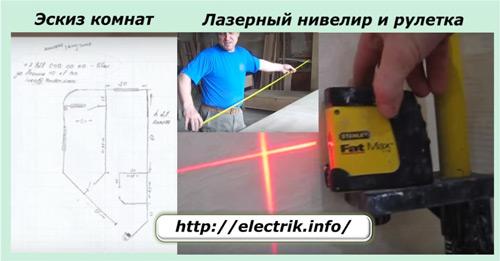
It is necessary to draw up a plan both during the initial construction, and during the next reconstruction of premises or improvements to the electrical circuit.
Drafting sequence:
1. definition on building structures locations of switching elements (switches, sockets, junction boxes) and consumers of electricity, including lamps, portable and stationary electrical appliances;
2. planning of lines of power wiring, computer networks and low-current circuits, determination of bypass of possible critical routes around water and gas pipelines, heating and sewage systems;
3. drawing up on paper sketches of rooms and drawing on them the planned places with the designation of sizes, allowing to calculate the need for materials.
During planning, it is necessary to clearly define:
-
places of installation of terminal wiring devices;
-
the configuration of the routes of cable channels to them, performed on the walls, floor or ceiling;
-
the composition of cables and wires for each connecting section and their cross section;
-
the length of the entire route and any of its elements;
-
interior design ideas.
Selection of component materials and tools
This stage is started after the project issues are completely resolved. Otherwise, there will be errors associated with the loss of material resources.
In the case of parallel laying of several cables, a box design is selected that corresponds to their cross-sectional dimensions. At the same time, it is taken into account that it is allowed to lay electric wires and low-current circuits in one cable channel, which is divided by special partitions.
For mounting on large spans between the supports, the configuration of a narrow tray with high edges is better than a wide form with low walls because it can withstand slightly larger loads. But in this case, it is more difficult to lay the cables.
On the basis of the project scheme, the required internal dimensions of the boxes for each section are determined and their division into main and branch ones with smaller sections is made. Accordingly, the length of each profile is calculated.
Cable ducts made of PVC are equipped with additional accessories that provide for fixing electrical wiring in certain ways and laying tracks at various angles, fixing the housings of various sockets and switches.

Many cable channels have devices for the integrated installation of sockets and switches for outdoor installation. This not only facilitates the work, but also looks beautiful.
Radially mounted inserts protect the wiring from mechanical stress at the joints of the walls, give the structure greater strength. Fixing plates allow to achieve a snug fit of the inner surface of the lid to the box. The amount of all purchased parts must be calculated after drawing up the project before going to the store.
At the same time, it is important to study the products offered by several manufacturers and choose the most suitable one according to technical parameters and design. Pay attention not only to the integrity of the ends and surfaces, but also to the operation of the locks.
Separate cable channels are available with prepared holes that are oval in shape for wall mounting. They allow you to slightly shift the housing in the axial direction during installation after installation of the mount until the final fixation of the long screws.
Special cable duct designs can even be mounted inside the underfloor.
According to the degree of protection of the installed cable, the designs of the boxes are divided into classes:
-
IP 00 - when all elements are made in a straight line and are not covered by covers;
-
IP 20 — a straight route is made with a perforated base and closed with covers;
-
IP 40 - straight lines of non-perforated elements, closed by covers;
-
IP 44 is the same as for IP 40, but with the use of an additional bandage on each connecting element covered with covers.
The method of fixing the box with screws is not the only one. You can use:
-
construction gun;
-
adhesive compositions;
-
adhesive double-sided tape.
Which one is best suited for specific conditions should be determined individually. However, when performing cable ducts inside the house, the fastest installation is with a construction gun. The use of dowels and screws is associated with drilling. And fixing with adhesives is recommended for small areas.
Since the individual structures of the boxes can be located between the vertical joints of the walls or used as ceiling or floor skirting boards, they are made in a shape close to a triangle. Other cable channels mounted at a distance from perpendicular surfaces are created with a rectangular profile or close to it.
PVC material has a certain strength and good operational resistance. At the same time, it is available for processing with conventional cutting tools: knives and saws with small teeth, drills, reinforced scissors, which are in the arsenal of almost every home master.
On sale are specialized devices designed for better and faster execution of cutouts, marking, joining adjacent surfaces. If you plan a large volume of installation, then such a tool will greatly facilitate the work.
Marking work on building structures
The quality of the marking determines the aesthetic appearance of the assembled cable channel and the entire room as a whole. Therefore, apply to its application should be responsible.
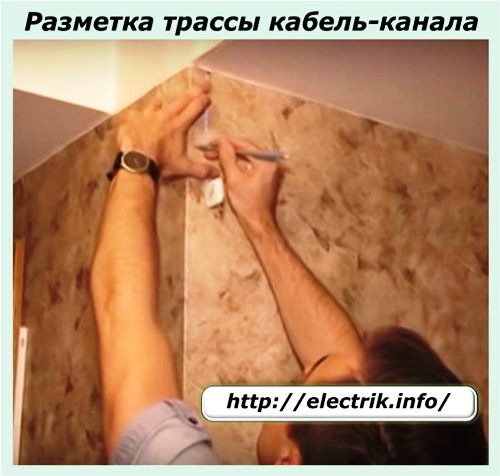
Mounted boxes look great on perfectly planned surfaces.If there are small irregularities on the walls, then they can be visually smoothed out due to the deflection of PVC materials and an increase in the frequency of fasteners.
Serious defects of curved walls will create problems during installation, will not allow you to perform the job beautifully. Therefore, it is better to align them in advance.
To design lines strictly in horizontal and vertical planes, it is necessary to use levels and plumb lines. Building cords, laser levels, infrared pointers allow you to mark quickly with high quality. See more about this here: How is the marking performed during wiring
If when marking up several options for the location of highways were considered, then the finally selected line should be distinguished from the rest by width or color. Otherwise, errors may occur when drilling surfaces.
Technological features of the installation of PVC box is composed of two parts:
1. a plastic case attached to a building structure;
2. A cover that covers the wires and is inserted into the locks of the box.
During installation, the boxes are first fixed to the walls, floor or ceiling, then the wiring is laid in them and then the removable covers are closed.
The standard length of the factory cable channel in these detachable parts is two meters. When it is not enough, the next building is simply docked to the previous one. If an excess of length is formed, then the body blank along with the lid is cut to the desired size.
Smooth joints can be obtained by sawing corners in special squares. Many craftsmen cut workpieces with electric hacksaws, jigsaws or grinders. In this case, very clear sections are obtained, but a lot of plastic dust is formed. It will have to be protected from its ingress into the body by glasses and respirators, and it will be necessary to clean manually from the floor and surrounding objects with a rag or vacuum cleaner.
After leaving the factory, the plastic structure undergoes numerous transportation and storage in different places, which does not always correspond to its safety. Defects from rough handling are manifested by cracks and chips on the side surfaces. Therefore, they must be inspected and leveled prior to installation on building structures.
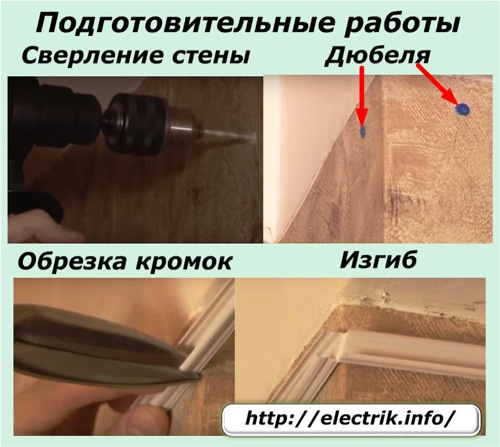
At the joints of the walls, the direction of the cable channel changes exactly 90 degrees. To perform this turn, it is allowed to trim the sides of the case with the cover on the turns and bend in the desired direction. In such places, a lot of time is spent on high-quality docking of parts. Special covers from the set of accessories beautifully cover problem areas and allow you to perform work quickly.
Cases for small low-current cables are available with solid walls without mounting holes, and are used for adhesive bonding. If you plan to install screws, then it is better to drill holes for them in advance. Overlaying the box with prepared holes when marking on the wall will allow you to accurately identify the drilling places and combine the self-tapping screw with the wall plug installed in the wall.
Fastening of the cases of boxes and junction boxes using a construction gun should be done through pre-prepared holes in the PVC case.
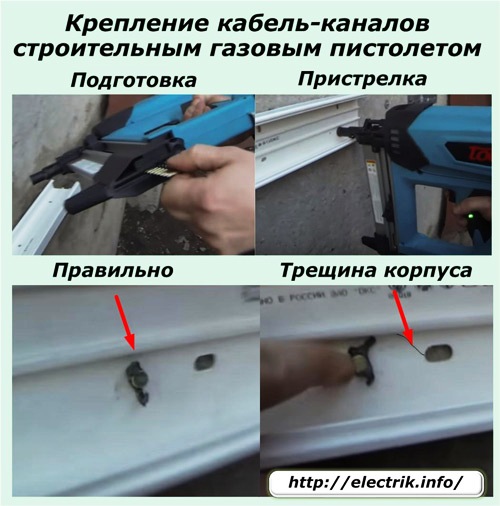
High-quality plastic most likely may not crack from a shot directly into the plastic and withstand its efforts, and performed even with minor violations of the technology will give deep cracks or even burst.
When several cables and wires are located inside the box, they should be carefully laid in parallel rows in their niches and secured with fastening jumpers, spacers or tied every half meter. All of these items can be purchased at the store. They are included in the accessory kit.
The wall material affects the way the cable channel is attached to it as follows:
1. The wooden structure allows you to screw ordinary screws into it;
2. brick, concrete and stone require preliminary drilling of sockets under the expansion bolt shield or use of a construction gun;
3. PVC panels, drywall and sheets of plywood or chipboard can withstand only special designs of screw-in devices in the form of butterflies;
4. places where drilling and recessing into the wall is not possible, allow only fixing with adhesive or double-sided adhesive tape.
In some cases, you can put a prepared box of short length on an already fixed cable.
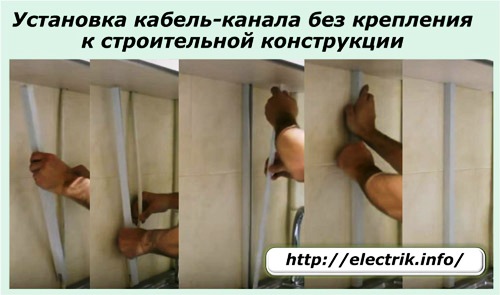
The completed cable channel design must have:
-
resistance to mechanical stress;
-
reliable cable protection;
-
the availability of reconstruction for electrical circuit modifications;
-
relatively low cost.
See also at bgv.electricianexp.com
:
